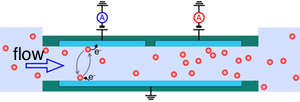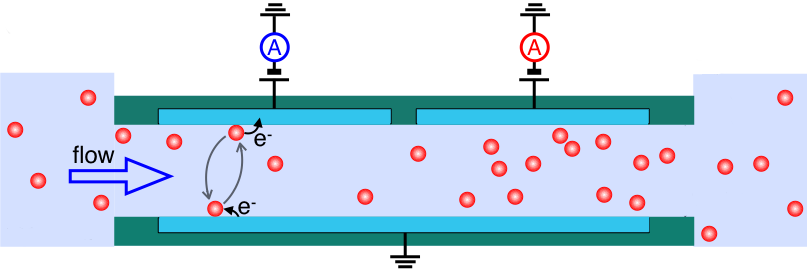Measuring the Smallest Trickle
A nano-sized plumbing experiment has measured the lowest fluid flow rate ever recorded, in the range of picoliters per minute, or milliliters per century. Reporting in Physical Review Letters, the researchers analyzed fluid flowing in an ultrathin channel. They used a statistical technique akin to tagging a parcel of fluid based on its momentary increase or decrease in the number of a specific molecule and then timing the parcel’s flow from one detector to another. The ability to measure such low flow rates could eventually be used to derive physical properties for enzymes and other complex molecules.
Many researchers are developing “lab-on-a-chip” technologies that could eventually allow quick and detailed biochemical analyses of small liquid samples, such as blood. These systems would require precise measurements of very small flow rates for calibrations and to measure properties such as the diffusion rate or reactivity of a biomolecule. But the usual techniques for observing fluid motion at small scales involve tracking fluorescent molecules with a microscope, which would be impractical in a lab-on-a-chip.
Serge Lemay and colleagues at the University of Twente in the Netherlands wanted to measure flow rates without optics equipment. The group cut a long slot or channel into a silicon wafer. When oriented correctly, the channel was 5 microns wide and just 130 nanometers high. The design incorporated two sensors along the length of the nanochannel, each consisting of metal electrodes at the top and bottom surfaces. The sensors can detect so-called electrochemically active molecules that the researchers dissolve in the fluid in the channel. When they apply a voltage across the electrodes, these molecules continuously carry electrons from the negative electrode to the positive electrode. A single molecule will perform this shuttle service several thousand times per second, ping-ponging back and forth to generate several femtoamperes of current. In previous work, the Twente group used this method to detect a single electrochemically active molecule in a nano channel [1].
For their latest experiment, the team pumped a water-based solution of electrochemically active molecules through their nanochannel. The currents measured by the two sensors varied with time due to random fluctuations in the number of current-carrying molecules between the electrodes. These fluctuations, which are caused by Brownian motion of the molecules, are typically too small to detect in a large volume, but they lead to significant variations in the current in the 10-femtoliter volume sampled by each sensor.
The fluctuations act as little markers for tracking the fluid flow, in the same way that clouds moving in the sky provide information on wind speed. With the help of a statistical analysis, the researchers essentially detected a fluctuation at the first sensor—say, a slight increase in current—and then measured how long it took to show up at the second sensor, which gave them the flow rate. The fluctuations only last about a second, so “the fluid has to be pushed fast enough so that you can still see a particular fluctuation in both sets of electrodes,” says Twente team member Klaus Mathwig. That detection limit turned out to be roughly 10 picoliters per minute. At this rate, it would take several years to pass a single, 30-microliter drop of water through the nanochannel.
“This work is part of the growing field of nanofluidics,” says Lydéric Bocquet of the University of Lyon in France. He finds the authors’ approach “very clever” in the way it mimics some of the statistical analysis used in fluorescence techniques. He thinks this all-electrical probe has advantages, however, over current optical methods, and Edgar Goluch of Northeastern University in Boston agrees. “The molecules [in the new experiment] do not have to be fluorescent or labeled in any way, which significantly expands what can be measured,” Goluch says. Moreover, the fluid dynamics are observable without cumbersome microscopes. “If iPhones are to ever start running complex diagnostic tests using lab-on-a-chip technology, they will need to measure the flow rate electronically,” Goluch says.
–Michael Schirber
Michael Schirber is a Corresponding Editor for Physics Magazine based in Lyon, France.
References
- M. A. G. Zevenbergen, P. S. Singh, E. D. Goluch, B. L. Wolfrum, and S. G. Lemay, ”Stochastic Sensing of Single Molecules in a Nanofluidic Electrochemical Device,” Nano Lett. 11, 2881 (2011)
More Information
Detection in Nanofluidic Channels (American Electrophoresis Society Newsletter), by Edgar Goluch
The incredible shrinking laboratory or “lab-on-a-chip” (Guardian newspaper), by Alok Jha





